Is Zagreb Green Enough? Influence of Urban Green Spaces on Mitigation of Urban Heat Island: A Satellite-Based Study
Abstract
1. Introduction
2. Material and Methods
2.1. Study Area
2.2. Image Selection and Results Presentation
2.3. Image Processing
- = spectral radiance;
- G = gain; obtained from the image metadata;
- B = bias; obtained from the image metadata;
- ND = digital number value.
- = apparent reflectance;
- = atmospherically corrected radiance;
- = correction factor of Sun−Earth distance;
- = exatmospheric solar irradiance;
- = solar zenith angle;
- = incident flow transmissivity;
- = ascendant flow transmissivity.
- = apparent reflectance without solar angle correction;
- = specific multiplying factor; obtained from the image metadata;
- = specific additive factor; obtained from the image metadata;
- = digital number value.
- = apparent reflectance;
- = apparent reflectance without solar angle correction;
- = solar zenith angle.
- and depend directly on the Planck equation: γ = T2sen/1256 Lλ; δ = T2sen − (T2sen/1256 Lλ);
- = radiant energy;
- Tsen = brightness temperature in K.
- = top of the atmosphere radiance;
- = radiance multiplier; constant for band 10 = 0.0003342;
- b = radiance adder; constant for band 10 = 0.1.
- = brightness temperature;
- = constant for the band 10 = 774.89;
- = constant for the band 10 = 1321.08;
- y = top of the atmosphere radiance.
- = land surface temperature;
- = emissivity.
3. Results
3.1. UHI Intensity Map
3.2. Thermal Profile Graphs
4. Discussion
5. Conclusions
Funding
Data Availability Statement
Acknowledgments
Conflicts of Interest
References
- Wang, H.; He, Q.; Liu, X.; Zhuang, Y.; Hong, S. Global urbanization research from 1991 to 2009: A systematic research review. Landsc. Urban Plan. 2012, 104, 299–309. [Google Scholar] [CrossRef]
- Rizwan, A.M.; Dennis, L.Y.; Liu, C. A review on the generation, determination and mitigation of Urban Heat Island. J. Environ. Sci. 2008, 20, 120–128. [Google Scholar] [CrossRef] [PubMed]
- Chen, X.L.; Zhao, H.M.; Li, P.X.; Yin, Z.Y. Remote sensing image-based analysis of the relationship between urban heat island and land use/cover changes. Remote Sens. Environ. 2006, 104, 133–146. [Google Scholar] [CrossRef]
- Piracha, A.; Chaudhary, M.T. Urban air pollution, urban heat island and human health: A review of the literature. Sustainability 2022, 14, 9234. [Google Scholar] [CrossRef]
- Mirzaei, P.A. Recent challenges in modeling of urban heat island. Sustain. Cities Soc. 2015, 19, 200–206. [Google Scholar] [CrossRef]
- Marando, F.; Heris, M.P.; Zulian, G.; Udías, A.; Mentaschi, L.; Chrysoulakis, N.; Parastatidis, D.; Maes, J. Urban heat island mitigation by green infrastructure in European Functional Urban Areas. Sustain. Cities Soc. 2022, 77, 103564. [Google Scholar] [CrossRef]
- Gunawardena, K.R.; Wells, M.J.; Kershaw, T. Utilising green and bluespace to mitigate urban heat island intensity. Sci. Total Environ. 2017, 584–585, 1040–1055. [Google Scholar] [CrossRef]
- Balany, F.; Ng, A.W.M.; Muttil, N.; Muthukumaran, S.; Wong, M.S. Green infrastructure as an urban heat island mitigation strategy—A review. Water 2020, 12, 3577. [Google Scholar] [CrossRef]
- Reyes-Riveros, R.; Altamirano, A.; De La Barrera, F.; Rozas-Vásquez, D.; Vieli, L.; Meli, P. Linking public urban green spaces and human well-being: A systematic review. Urban For. Urban Green. 2021, 61, 127105. [Google Scholar] [CrossRef]
- Van Oijstaeijen, W.; Van Passel, S.; Cools, J. Urban green infrastructure: A review on valuation toolkits from an urban planning perspective. J. Environ. Manag. 2020, 267, 110603. [Google Scholar] [CrossRef]
- Xiao, X.D.; Dong, L.; Yan, H.; Yang, N.; Xiong, Y. The influence of the spatial characteristics of urban green space on the urban heat island effect in Suzhou Industrial Park. Sustain. Cities Soc. 2018, 40, 428–439. [Google Scholar] [CrossRef]
- Aram, F.; García, E.H.; Solgi, E.; Mansournia, S. Urban green space cooling effect in cities. Heliyon 2019, 5, e01339. [Google Scholar] [CrossRef] [PubMed]
- Nastran, M.; Kobal, M.; Eler, K. Urban heat islands in relation to green land use in European cities. Urban For. Urban Green. 2019, 37, 33–41. [Google Scholar] [CrossRef]
- Zoulia, I.; Santamouris, M.; Dimoudi, A. Monitoring the effect of urban green areas on the heat island in Athens. Environ. Monit. Assess. 2009, 156, 275–292. [Google Scholar] [CrossRef] [PubMed]
- Xu, C.; Chen, G.; Huang, Q.; Su, M.; Rong, Q.; Yue, W.; Haase, D. Can improving the spatial equity of urban green space mitigate the effect of urban heat islands? An empirical study. Sci. Total Environ. 2022, 841, 156687. [Google Scholar] [CrossRef]
- Klemm, W.; Heusinkveld, B.G.; Lenzholzer, S.; van Hove, B. Street greenery and its physical and psychological impact on thermal comfort. Landsc. Urban Plan. 2015, 138, 87–98. [Google Scholar] [CrossRef]
- Lobaccaro, G.; Acero, J.A. Comparative analysis of green actions to improve outdoor thermal comfort inside typical urban street canyons. Urban Clim. 2015, 14, 251–267. [Google Scholar] [CrossRef]
- Weng, Q.; Lu, D.; Schubring, J. Estimation of land surface temperature-vegetation abundance relationship for urban heat island studies. Remote Sens. Environ. 2004, 89, 467–483. [Google Scholar] [CrossRef]
- Ward, K.; Lauf, S.; Kleinschmit, B.; Endlicher, W. Heat waves and urban heat islands in Europe: A review of relevant drivers. Sci. Total Environ. 2016, 569–570, 527–539. [Google Scholar] [CrossRef]
- Bao, T.; Li, X.; Zhang, J.; Zhang, Y.; Tian, S. Assessing the Distribution of Urban Green Spaces and its Anisotropic Cooling Distance on Urban Heat Island Pattern in Baotou, China. ISPRS Int. J. Geoinf. 2016, 5, 12. [Google Scholar] [CrossRef]
- Abebe, M.T.; Megento, T.L. The city of addis ababa from ‘forest city’ to ‘urban heat island’: Assessment of urban green space dynamics. J. Urban Environ. Eng. 2016, 10, 254–262. [Google Scholar] [CrossRef]
- Maheng, D.; Ducton, I.; Lauwaet, D.; Zevenbergen, C.; Pathirana, A. The sensitivity of urban heat island to urban green space-A model-based study of City of Colombo, Sri Lanka. Atmosphere 2019, 10, 151. [Google Scholar] [CrossRef]
- Doick, K.J.; Peace, A.; Hutchings, T.R. The role of one large greenspace in mitigating London’s nocturnal urban heat island. Sci. Total Environ. 2014, 493, 662–671. [Google Scholar] [CrossRef] [PubMed]
- Park, J.; Kim, J.H.; Lee, D.K.; Park, C.Y.; Jeong, S.G. The influence of small green space type and structure at the street level on urban heat island mitigation. Urban For. Urban Green. 2017, 21, 203–212. [Google Scholar] [CrossRef]
- Shastri, H.; Ghosh, S. Urbanisation and Surface Urban Heat Island Intensity (SUHII). In Climate Change Signals and Response: A Strategic Knowledge Compendium for India; Springer: Berlin/Heidelberg, Germany, 2019; pp. 73–90. [Google Scholar] [CrossRef]
- Krtalić, A.; Kuveždi, A.; Mrlec, K. Satellite-driven assessment of surface urban heat islands in the city of zagreb, croatia. ISPRS Ann. Photogramm. Remote Sens. Spat. Inf. Sci. 2020, 5, 757–764. [Google Scholar] [CrossRef]
- Zhou, D.; Xiao, J.; Bonafoni, S.; Berger, C.; Deilami, K.; Zhou, Y.; Frolking, S.; Yao, R.; Qiao, Z.; Sobrino, J.A. Satellite remote sensing of surface urban heat islands: Progress, challenges, and perspectives. Remote Sens. 2019, 11, 48. [Google Scholar] [CrossRef]
- de Almeida, C.R.; Teodoro, A.C.; Gonçalves, A. Study of the urban heat island (Uhi) using remote sensing data/techniques: A systematic review. Environments 2021, 8, 105. [Google Scholar] [CrossRef]
- Sobrino, J.A.; Oltra-Carrió, R.; Sòria, G.; Jiménez-Muñoz, J.C.; Franch, B.; Hidalgo, V.; Mattar, C.; Julien, Y.; Cuenca, J.; Romaguera, M.; et al. Evaluation of the surface urban heat island effect in the city of Madrid by thermal remote sensing. Int. J. Remote Sens. 2013, 34, 3177–3192. [Google Scholar] [CrossRef]
- Martin, P.; Baudouin, Y.; Gachon, P. An alternative method to characterize the surface urban heat island. Int. J. Biometeorol. 2015, 59, 849–861. [Google Scholar] [CrossRef]
- Bonacci, O.; Roje-Bonacci, T.; Vrsalović, A. The day-to-day temperature variability method as a tool for urban heat island analysis: A case of Zagreb-Grič Observatory (1887–2018). Urban Clim. 2022, 45, 101281. [Google Scholar] [CrossRef]
- Nitis, T.; Klaic, Z.B.; Moussiopoulos, N. Effects of topography on urban heat island. In Proceedings of the 10th International Conference on Harmonisation within Atmospheric Dispersion Modelling for Regulatory Purposes, Garmisch-Partenkirchen, Germany, 1–4 June 2005; Volume 1, p. 5. [Google Scholar]
- Nimac, I.; Herceg-Bulić, I.; Žuvela-Aloise, M.; Žgela, M. Impact of North Atlantic Oscillation and drought conditions on summer urban heat load—A case study for Zagreb. Int. J. Climatol. 2022, 42, 4850–4867. [Google Scholar] [CrossRef]
- Milić, B. Urbani razvoj gradova na tlu Hrvatske—19. stoljeće, Urban Development of Croatian towns in 19th Century. Prost. Znan. Časopis Za Arhit. I Urban. 2006, 14, 197–217. [Google Scholar]
- Franković, E. Urbanističko planiranje Zagreba od 1945. do 1985. Radovi Instituta za Povijest Umjetnosti, 1985, pp. 85–87. Available online: https://hrcak.srce.hr/file/327987 (accessed on 5 February 2024).
- Lohmann, U.; Sausen, R.; Bengtsson, L.; Cubasch, U.; Pelwitz, J.; Roeckner, E. The Köppen climate classification as a diagnostic tool for general circulation models. Clim. Res. 1993, 3, 177–193. [Google Scholar] [CrossRef]
- Greenacre, M.; Groenen, P.J.F.; Hastie, T.; D’Enza, A.I.; Markos, A.; Tuzhilina, E. Principal component analysis. Nat. Rev. Methods Primers 2022, 2, 433–459. [Google Scholar] [CrossRef]
- Pettorelli, N.; Vik, J.O.; Mysterud, A.; Gaillard, J.M.; Tucker, C.J.; Stenseth, N.C. Using the satellite-derived NDVI to assess ecological responses to environmental change. Trends Ecol. Evol. 2005, 20, 503–510. [Google Scholar] [CrossRef]
- Barsi, J.A.; Schott, J.R.; Hook, S.J.; Raqueno, N.G.; Markham, B.L.; Radocinski, R.G. Landsat-8 thermal infrared sensor (TIRS) vicarious radiometric calibration. Remote Sens. 2014, 6, 11607–11626. [Google Scholar] [CrossRef]
- Chuvieco, E. Teledetección Medioambiental; Ariel: Barcelona, Spain, 2010. [Google Scholar]
- Jiménez-Munoz, J.C.; Sobrino, J.A. A generalized single-channel method for retrieving land surface temperature from remote sensing data. J. Geophys. Res. Atmos. 2003, 108, 22. [Google Scholar] [CrossRef]
- Stathopoulou, M.; Cartalis, C.; Petrakis, M. Integrating Corine Land Cover data and Landsat TM for surface emissivity definition: Application to the urban area of Athens, Greece. Int. J. Remote Sens. 2007, 28, 3291–3304. [Google Scholar] [CrossRef]
- Sobrino, J.A.; Raissouni, N.; Li, Z.L. A comparative study of land surface emissivity retrieval from NOAA data. Remote Sens. Environ. 2001, 75, 256–266. [Google Scholar] [CrossRef]
- Valor, E.; Caselles, V. Mapping land surface emissivity from NDVI: Application to European, African, and South American areas. Remote Sens. Environ. 1996, 57, 167–184. [Google Scholar] [CrossRef]
- Saaroni, H.; Amorim, J.H.; Hiemstra, J.A.; Pearlmutter, D. Urban Green Infrastructure as a tool for urban heat mitigation: Survey of research methodologies and findings across different climatic regions. Urban Clim. 2018, 24, 94–110. [Google Scholar] [CrossRef]
- Semenzato, P.; Bortolini, L. Urban Heat Island Mitigation and Urban Green Spaces: Testing a Model in the City of Padova (Italy). Land 2023, 12, 476. [Google Scholar] [CrossRef]
- Zhou, W.; Yu, W.; Zhang, Z.; Cao, W.; Wu, T. How can urban green spaces be planned to mitigate urban heat island effect under different climatic backgrounds? A threshold-based perspective. Sci. Total Environ. 2023, 890, 164422. [Google Scholar] [CrossRef] [PubMed]
- Millennium Ecosystem Assessment. Ecosystems and Human Well-Being; World Resources Institute: Washington, DC, USA, 2005; Available online: http://pdf.wri.org/ecosystems_human_wellbeing.pdf (accessed on 3 October 2024).
- Woodruff, S.C.; BenDor, T.K. Ecosystem services in urban planning: Comparative paradigms and guidelines for high quality plans. Landsc. Urban Plan. 2016, 152, 90–100. [Google Scholar] [CrossRef]
- Krishnan, S. Planning for Ecosystem Services in Cities; Springer Nature: London, UK, 2021; Volume 14. [Google Scholar] [CrossRef]
- Ahern, J.; Cilliers, S.; Niemelä, J. The concept of ecosystem services in adaptive urban planning and design: A framework for supporting innovation. Landsc. Urban Plan. 2014, 125, 254–259. [Google Scholar] [CrossRef]
- Vieira, J.; Matos, P.; Mexia, T.; Silva, P.; Lopes, N.; Freitas, C.; Correia, O.; Santos-Reis, M.; Branquinho, C.; Pinho, P. Green spaces are not all the same for the provision of air purification and climate regulation services: The case of urban parks. Environ. Res. 2018, 160, 306–313. [Google Scholar] [CrossRef]
- Lin, B.B.; Meyers, J.; Beaty, R.M.; Barnett, G.B. Urban green infrastructure impacts on climate regulation services in Sydney, Australia. Sustainability 2016, 8, 788. [Google Scholar] [CrossRef]
- Goldenberg, R.; Kalantari, Z.; Destouni, G. Comparative quantification of local climate regulation by green and blue urban areas in cities across Europe. Sci. Rep. 2021, 11, 23872. [Google Scholar] [CrossRef]
- Esfehankalateh, A.T.; Ngarambe, J.; Yun, G.Y. Influence of tree canopy coverage and leaf area density on urban heat island mitigation. Sustainability 2021, 13, 7496. [Google Scholar] [CrossRef]
- Morabito, M.; Crisci, A.; Guerri, G.; Messeri, A.; Congedo, L.; Munafò, M. Surface urban heat islands in Italian metropolitan cities: Tree cover and impervious surface influences. Sci. Total Environ. 2021, 751, 142334. [Google Scholar] [CrossRef]
- Greene, C.S.; Kedron, P.J. Beyond fractional coverage: A multilevel approach to analyzing the impact of urban tree canopy structure on surface urban heat islands. Appl. Geogr. 2018, 95, 45–53. [Google Scholar] [CrossRef]
- Eyster, H.N.; Beckage, B. Arboreal Urban Cooling Is Driven by Leaf Area Index, Leaf Boundary Layer Resistance, and Dry Leaf Mass per Leaf Area: Evidence from a System Dynamics Model. Atmosphere 2023, 14, 552. [Google Scholar] [CrossRef]
- Liu, B.; Guo, X.; Jiang, J. How Urban Morphology Relates to the Urban Heat Island Effect: A Multi-Indicator Study. Sustainability 2023, 15, 787. [Google Scholar] [CrossRef]
- Peng, W.; Wang, R.; Duan, J.; Gao, W.; Fan, Z. Surface and canopy urban heat islands: Does urban morphology result in the spatiotemporal differences? Urban Clim. 2022, 42, 101136. [Google Scholar] [CrossRef]
- Kolokotsa, D.; Lilli, K.; Gobakis, K.; Mavrigiannaki, A.; Haddad, S.; Garshasbi, S.; Mohajer, H.R.H.; Paolini, R.; Vasilakopoulou, K.; Bartesaghi, C.; et al. Analyzing the Impact of Urban Planning and Building Typologies in Urban Heat Island Mitigation. Buildings 2022, 12, 537. [Google Scholar] [CrossRef]
- Loughner, C.P.; Allen, D.J.; Zhang, D.L.; Pickering, K.E.; Dickerson, R.R.; Landry, L. Roles of urban tree canopy and buildings in urban heat island effects: Parameterization and preliminary results. J. Appl. Meteorol. Clim. 2012, 51, 1775–1793. [Google Scholar] [CrossRef]
- Yuan, C.; Adelia, A.S.; Mei, S.; He, W.; Li, X.X.; Norford, L. Mitigating intensity of urban heat island by better understanding on urban morphology and anthropogenic heat dispersion. Build. Environ. 2020, 176, 106876. [Google Scholar] [CrossRef]
- Santos, L.G.R.; Nevat, I.; Pignatta, G.; Norford, L.K. Climate-informed decision-making for urban design: Assessing the impact of urban morphology on urban heat island. Urban Clim. 2021, 36, 100776. [Google Scholar] [CrossRef]
- Liao, W.; Hong, T.; Heo, Y. The effect of spatial heterogeneity in urban morphology on surface urban heat islands. Energy Build. 2021, 244, 111027. [Google Scholar] [CrossRef]
- Ivanković, V. Western Part of Zagreb in Regulatory Plans form 1865, 1887 and 1907. E-Zb. Elektron. Zb. Rad. Građevinskog Fak. 2024, 14, 26–35. [Google Scholar] [CrossRef]
- Čavlović, M.; Lovrenčić, L.; Sevšek, A.; Lovrenčić, L.; Sevšek, A. The two ‘halves’ of New Zagreb. In Mapping Urban Changes; Škarić, A.P., Ed.; Institut za povijest umjetnosti: Zagreb, Croatia, 2017; pp. 1–24. [Google Scholar]
- Zoranić, A. Residential architecture of Novi Zagreb on the example of Siget settlement. Period. Eng. Nat. Sci. USA 2022, 10, 56–64. [Google Scholar] [CrossRef]
- Milan, C. From the streets to the town halls: Municipalist platforms in the post-Yugoslav space. Urban Stud. 2023, 60, 2158–2175. [Google Scholar] [CrossRef]
- Gašparović, S.; Sopina, A. Uloga pejsaža u planiranju grada Zagreba od početka 20. do početka 21. stoljeća. Prostor 2018, 26, 132–145. [Google Scholar] [CrossRef]
- Bešević, M.; Miličić, I.M.; Gabric, O.; Gabric, O. 4th International Conference Contemporary Achievements in Civil Engineering 2016 Faculty of Civil Engineering; University of Novi Sad, Faculty of Civil Engineering Subotica: Subotica, Serbia, 2016. [Google Scholar]
- Gotovac, A.S.; Podgorelec, S.; Villa, Z.K.-D. the Quality of Life in Housing Estates in the Context of West-European and Post-Socialist Countries1. Geoadria 2021, 26, 143–166. [Google Scholar] [CrossRef]
- Schwarz, N.; Schlink, U.; Franck, U.; Großmann, K. Relationship of land surface and air temperatures and its implications for quantifying urban heat island indicators—An application for the city of Leipzig (Germany). Ecol. Indic. 2012, 18, 693–704. [Google Scholar] [CrossRef]
- Li, L.; Zha, Y.; Wang, R. Relationship of surface urban heat island with air temperature and precipitation in global large cities. Ecol. Indic. 2020, 117, 106683. [Google Scholar] [CrossRef]
- Sheng, L.; Tang, X.; You, H.; Gu, Q.; Hu, H. Comparison of the urban heat island intensity quantified by using air temperature and Landsat land surface temperature in Hangzhou, China. Ecol. Indic. 2017, 72, 738–746. [Google Scholar] [CrossRef]
- Bolund, P.; Hunhammar, S. Ecosystem services in urban areas. Ecol. Econ. 1999, 29, 293–301. [Google Scholar] [CrossRef]
- Gómez-Baggethun, E.; Barton, D.N. Classifying and valuing ecosystem services for urban planning. Ecol. Econ. 2013, 86, 235–245. [Google Scholar] [CrossRef]
- Kičić, M.; Haase, D.; Marin, A.M.; Vuletić, D.; Ostoić, S.K. Perceptions of cultural ecosystem services of tree-based green infrastructure: A focus group participatory mapping in Zagreb, Croatia. Urban For. Urban Green. 2022, 78, 127767. [Google Scholar] [CrossRef]
- Ostoić, S.K.; Marin, A.M.; Kičić, M.; Vuletić, D. Qualitative exploration of perception and use of cultural ecosystem services from tree-based urban green space in the city of zagreb (Croatia). Forests 2020, 11, 876. [Google Scholar] [CrossRef]
- Sylla, M.; Hagemann, N.; Szewrański, S. Mapping trade-offs and synergies among peri-urban ecosystem services to address spatial policy. Environ. Sci. Policy 2020, 112, 79–90. [Google Scholar] [CrossRef]
- Spyra, M.; La Rosa, D.; Zasada, I.; Sylla, M.; Shkaruba, A. Governance of ecosystem services trade-offs in peri-urban landscapes. Land Use Policy 2020, 95, 104617. [Google Scholar] [CrossRef]
- Tandarić, N.; Ives, C.D.; Watkins, C. From city in the park to ‘greenery in plant pots’: The influence of socialist and post-socialist planning on opportunities for cultural ecosystem services. Land Use Policy 2022, 120, 106309. [Google Scholar] [CrossRef]
- Seletković, A.; Kičić, M.; Ančić, M.; Kolić, J.; Pernar, R. The Urban Heat Island Analysis for the City of Zagreb in the Period 2013–2022 Utilizing Landsat 8 Satellite Imagery. Sustainability 2023, 15, 3963. [Google Scholar] [CrossRef]
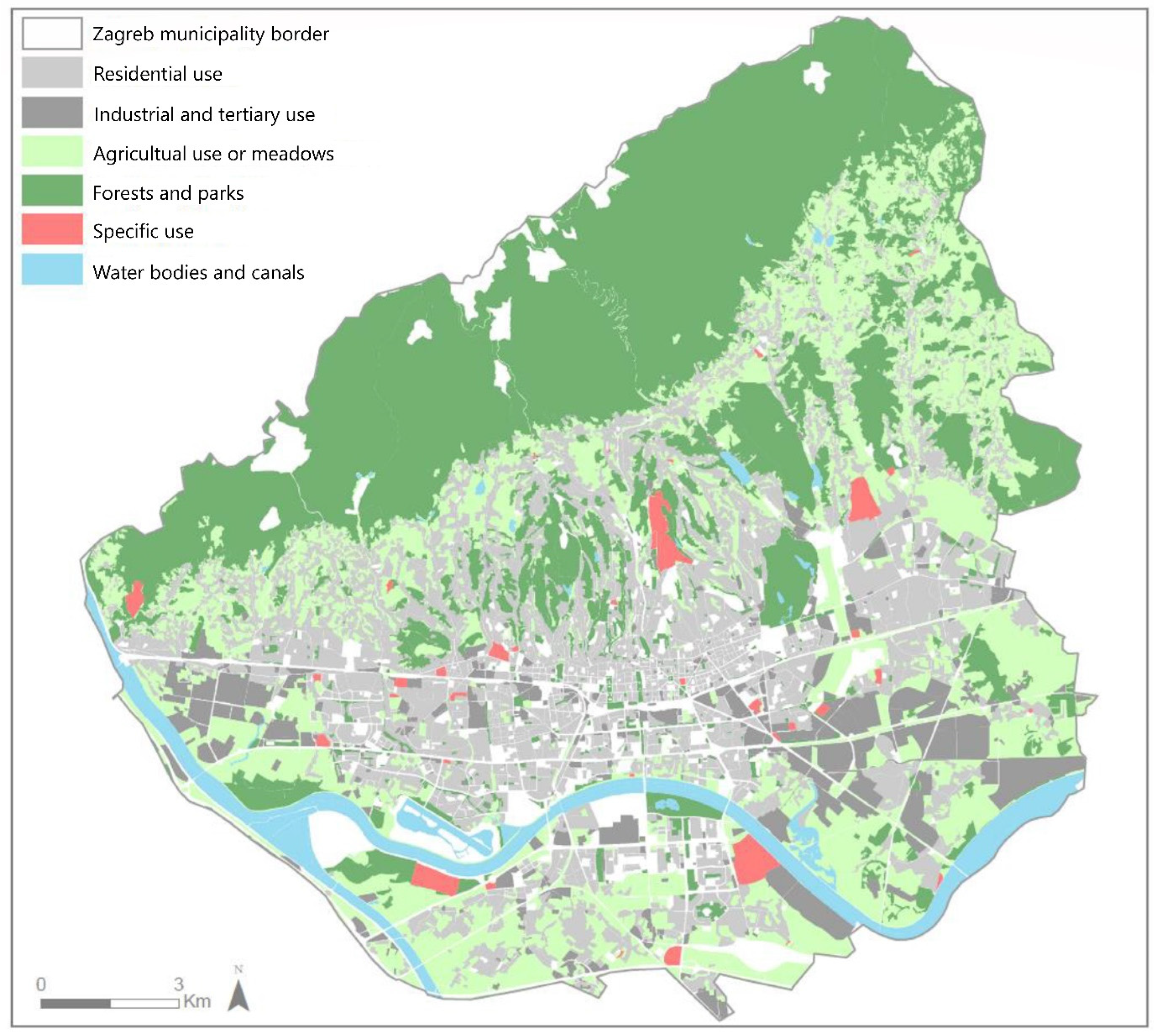

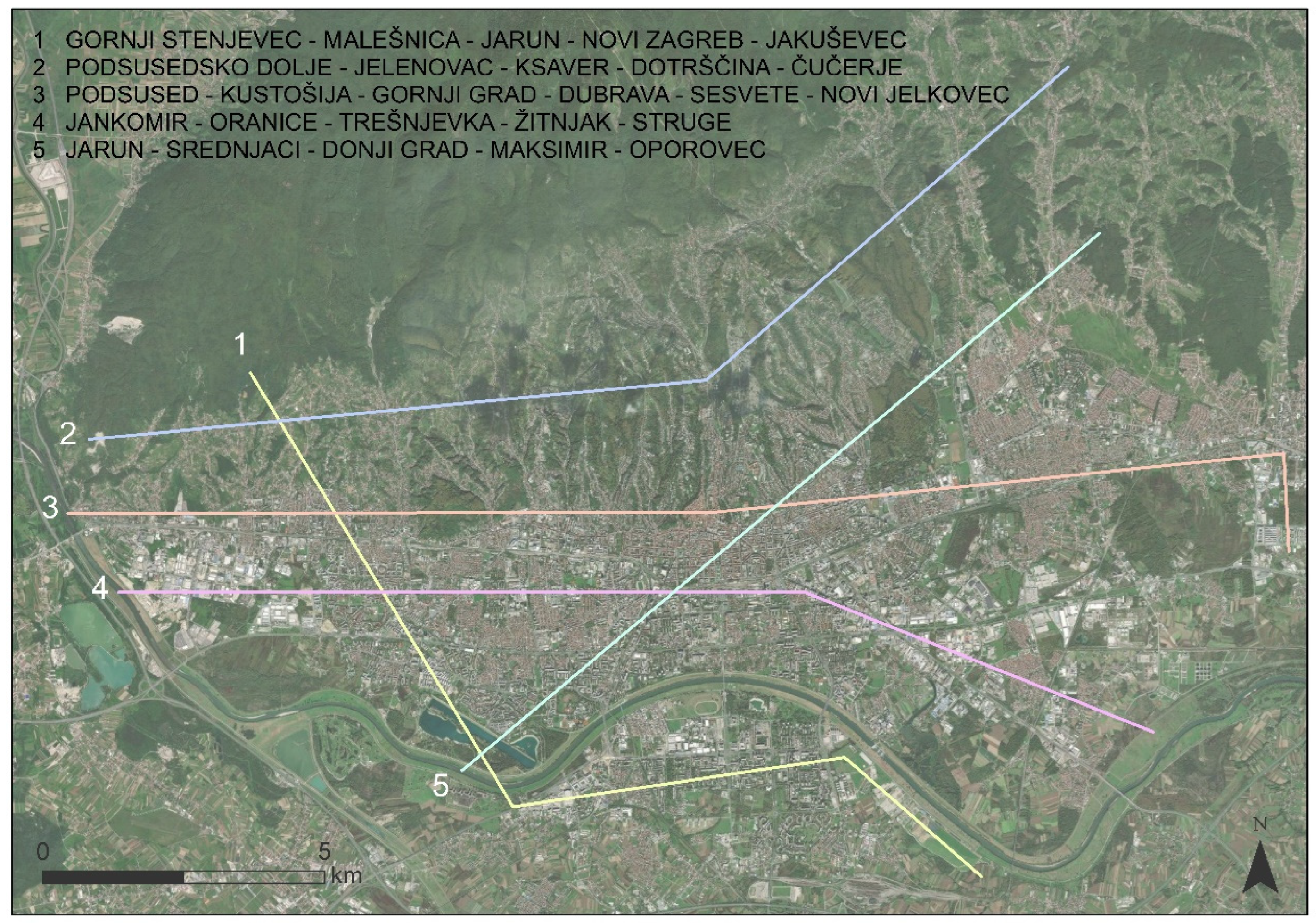
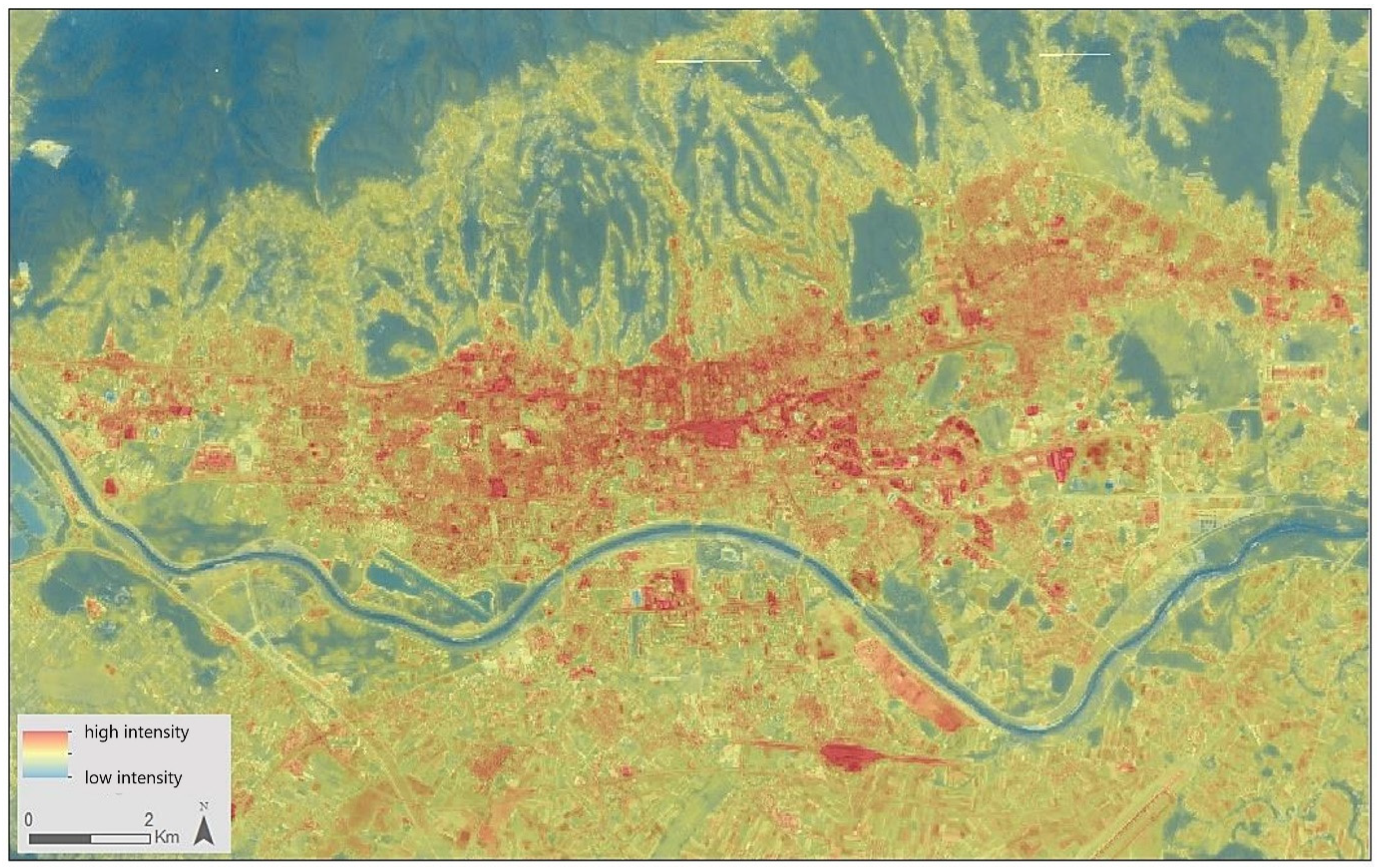
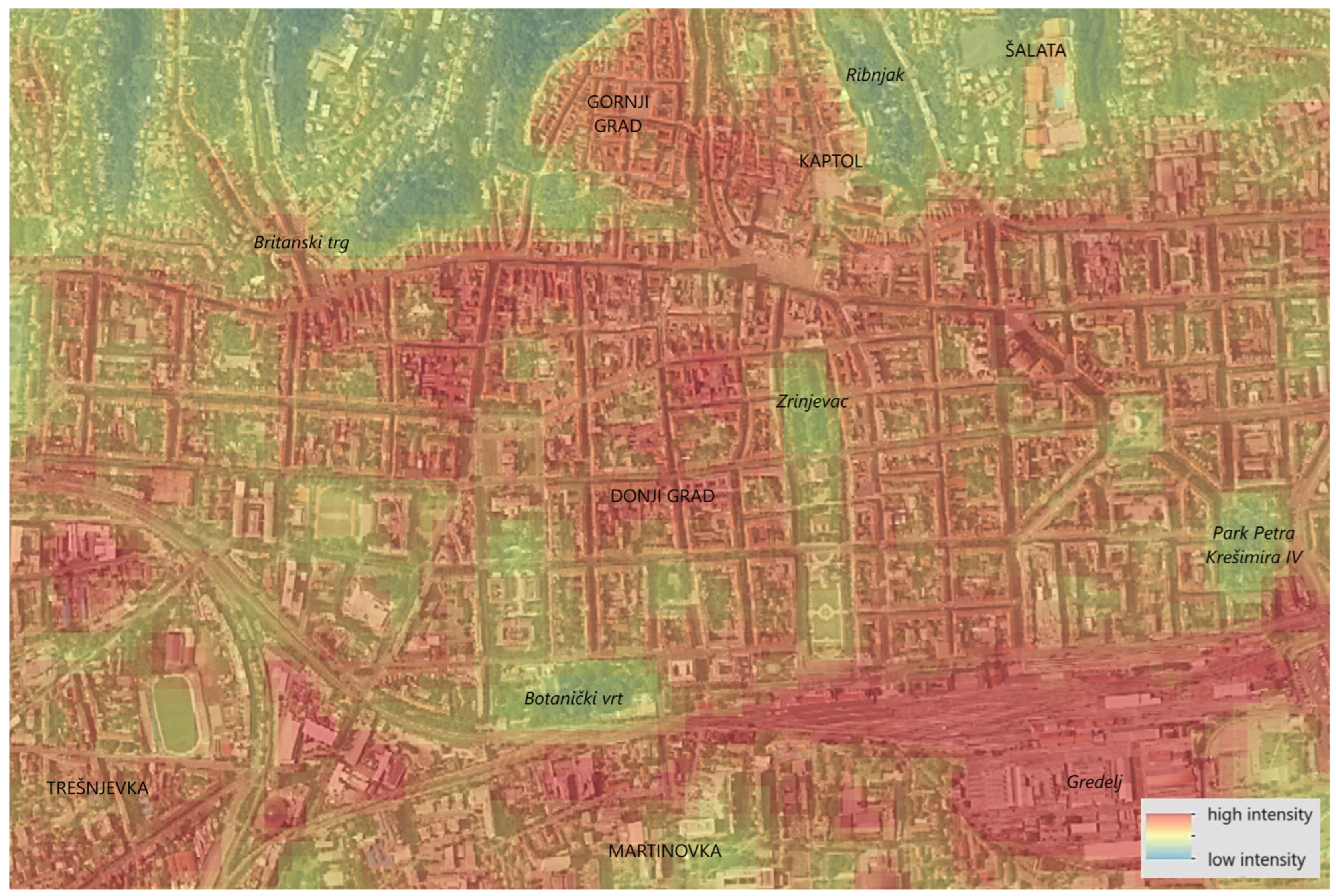

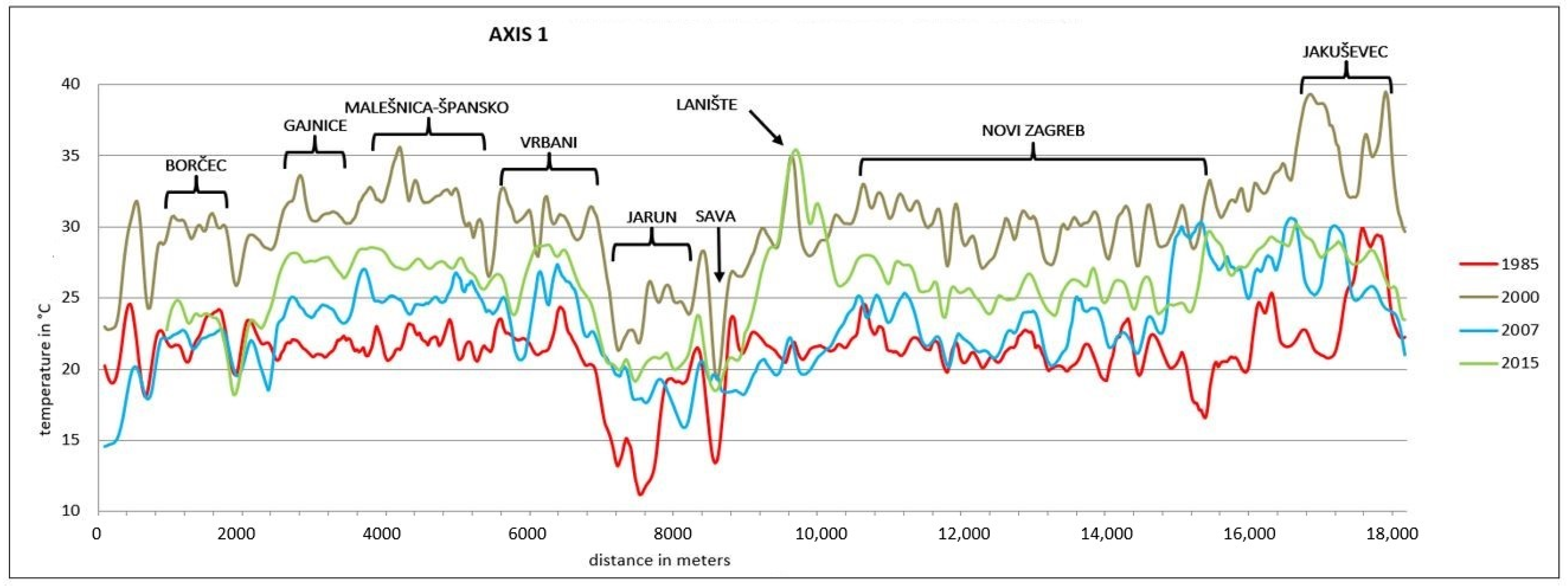
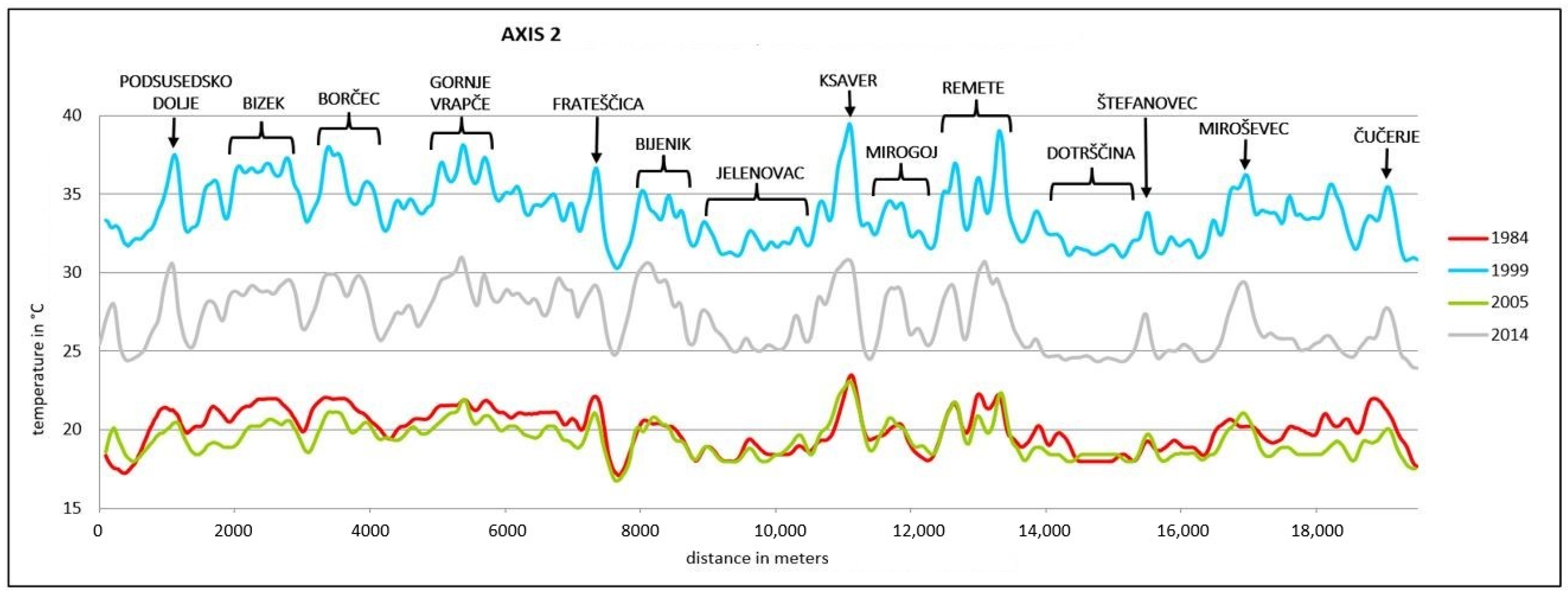
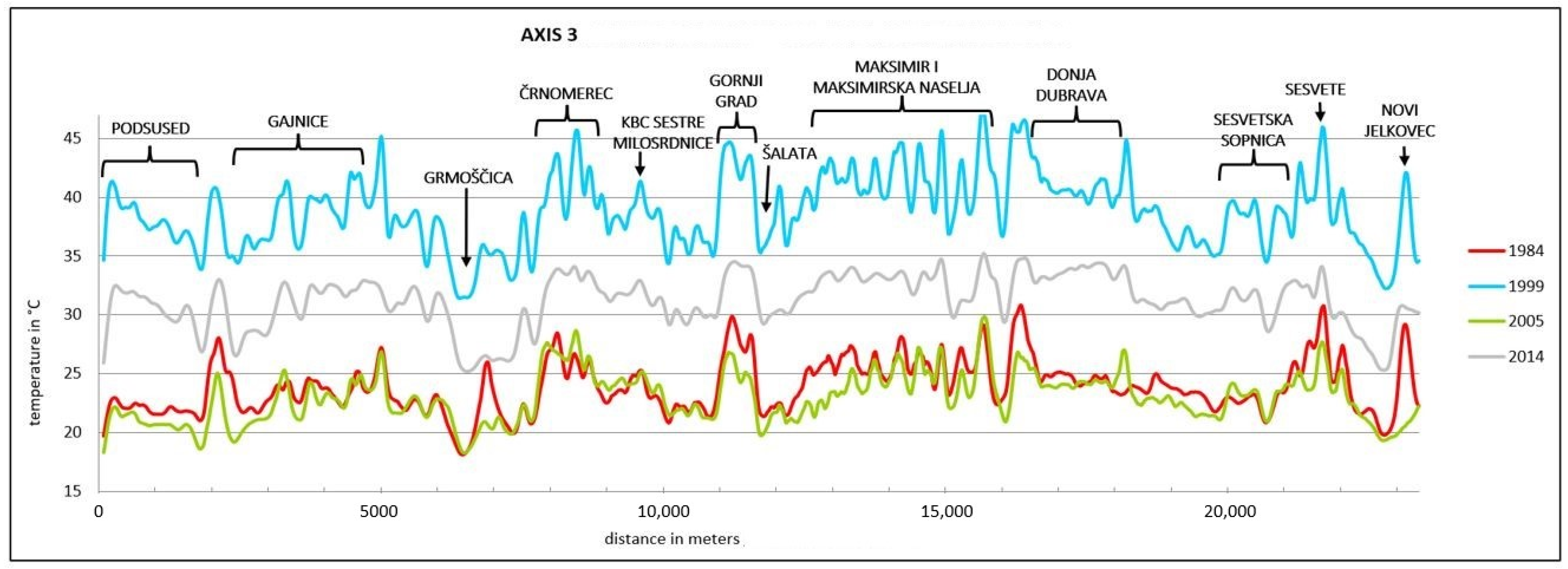


| Image Date | Satellite/Sensor | Thermal Profile Analysis | UHI Intensity Map Analysis |
|---|---|---|---|
| 21 August 1984 | Landsat 5/TM | X | X |
| 2 April 1985 | Landsat 5/TM | X | X |
| 7 August 1999 | Landsat 7/ETM+ | X | X |
| 19 April 2000 | Landsat 7/ETM+ | X | X |
| 12 August 2001 | Landsat 7/ETM+ | X | |
| 11 May 2002 | Landsat 7/ETM+ | X | |
| 14 July 2005 | Landsat 5/TM | X | |
| 1 May 2007 | Landsat 7/ETM+ | X | X |
| 7 July 2014 | Landsat 8/OLI, TIRS | X | X |
| 7 May 2015 | Landsat 8/OLI, TIRS | X |
| Land Cover | NDVI Thresholds | Emissivity |
|---|---|---|
| Vegetation | >0.5 | 0.99 |
| Water | <−0.5 | 0.98 |
| Built-up areas | −0.5 <= NDVI <= 0.1 | 0.95 |
| Bare soil | 0.1 <= NDVI <= 0.2 | 0.94 |
| Mixed pixels | 0.2 <= NDVI <= 0.5 | Valor and Caselles [44] |
Disclaimer/Publisher’s Note: The statements, opinions and data contained in all publications are solely those of the individual author(s) and contributor(s) and not of MDPI and/or the editor(s). MDPI and/or the editor(s) disclaim responsibility for any injury to people or property resulting from any ideas, methods, instructions or products referred to in the content. |
© 2024 by the author. Licensee MDPI, Basel, Switzerland. This article is an open access article distributed under the terms and conditions of the Creative Commons Attribution (CC BY) license (https://creativecommons.org/licenses/by/4.0/).
Share and Cite
Krsnik, G. Is Zagreb Green Enough? Influence of Urban Green Spaces on Mitigation of Urban Heat Island: A Satellite-Based Study. Earth 2024, 5, 604-622. https://doi.org/10.3390/earth5040031
Krsnik G. Is Zagreb Green Enough? Influence of Urban Green Spaces on Mitigation of Urban Heat Island: A Satellite-Based Study. Earth. 2024; 5(4):604-622. https://doi.org/10.3390/earth5040031
Chicago/Turabian StyleKrsnik, Goran. 2024. "Is Zagreb Green Enough? Influence of Urban Green Spaces on Mitigation of Urban Heat Island: A Satellite-Based Study" Earth 5, no. 4: 604-622. https://doi.org/10.3390/earth5040031
APA StyleKrsnik, G. (2024). Is Zagreb Green Enough? Influence of Urban Green Spaces on Mitigation of Urban Heat Island: A Satellite-Based Study. Earth, 5(4), 604-622. https://doi.org/10.3390/earth5040031






